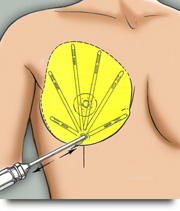
Gynecomastia is a problem that expresses breast size in men as in women. This problem is usually caused by genetic factors, hormonal changes, weight problems and some medications used.
Gynecomastia, which does not threaten health, should be treated because it negatively affects the social life of the patient. Gynecomastia is a problem with treatment. Gynecomastia is a problem divided into three degrees.
Mild breast lubrication in the first degree, mammary gland swelling in the second degree, and both lubrication and abnormal growth in the mammary glands are seen in the third degree. The doctor will decide what degree the patient has and which treatment should be applied as a result of the examinations he/she has made.
What is Gynecomastia Surgery?
Gynecomastia surgery is a surgical operation performed in men to solve the gynecomastia problem, which is mostly caused by an imbalance of estrogen and testosterone hormones or hormonal disorders.
How is Gynecomastia Surgery done?
For the treatment of gynecomastia, the underlying cause of this problem should be found first and applied accordingly.
If gynecomastia is in the first degree, that is, breast lubrication, liposuction is the solution. In this application, an incision of one cm is made from each breast and the excess fat tissues in the breast are taken out.
If gynecomastia is secondary, that is, if the mammary glands are swollen and rich in breast tissue, liposuction will not work. In this case, special tips can be used to divide the breast tissue and throw it out.
In very advanced people with third degree, tissue removal can be done through small holes. Again, for patients with advanced gynecomastia, skin tightening can be achieved with vaser or laser liposuction applications. In very rare cases, when these applications are not sufficient, skin removal can be performed directly with the breast tissue. While the applications are made simple and comfortable with the application of local anesthesia or sedation in breasts with excess fat tissue, general anesthesia is preferred in breasts with larger and more breast tissue.
People who are administered general anesthesia stay in the hospital the night of the operation, while people who are treated with local anesthesia or sedation can be discharged from the hospital on the same day. The reason for the patient to stay in the hospital for one night after general anesthesia is to monitor the reaction of the patient to the anesthesia after the surgery and keep it under control.

Generally;
× Glandular type gynecomastia type with hard breast tissue surgically,
× As mixed type gynecomastia surgery and liposuction where glandular tissue and adipose tissue are high,
× Fatty type gynecomastia, in which adipose tissue is predominant, is treated only with liposuction.
Who is a suitable candidate for Gynecomastia Surgery ?
Since gynecomastia problem is seen in men with female type breast enlargement, it is a surgical operation performed if it is deemed appropriate for the person who applied to the hospital with this complaint.
The criterion required for gynecomastia surgery is that the sagging of the nipple is normally between 50-100 cc in volume, while it increases to 200-300 cc in gynecomastia.
Who cannot have gynecomastia surgery?
The gynecomastia problem may develop in some people during adolescence and may regress. Therefore, gynecomastia surgery is performed at the age of 17 at the earliest. Not applicable to persons under the age of 17.
What is the preparation period for Gynecomastia Surgery ?
During the preparation period for gynecomastia surgery, if the degree of gynecomastia problem is not advanced, diet and exercise are tried first. It is recommended that patients do not consume herbal tea before surgery, do not use food supplements, and do not consume blood thinning red fruits.
Since smoking and alcohol impair blood circulation and delay the healing of tissues, it should be stopped one week before the surgery and should not be consumed in the first week after the surgery. If the patient is using aspirin-derived blood thinners, he should share it with his doctor before the surgery.
What is the recovery period after gynecomastia surgery ?
The process experienced during the recovery period after gynecomastia surgery differs according to the technique of the surgery.
If vaser or laser liposuction is preferred in the treatment of gynecomastia, the recovery period is shorter and simpler. If the gynecomastia problem is caused by the excess of adipose tissue, vaser liposuction or laser liposuction applications can make the patient very satisfied and show their effect at the end of three weeks.
In the gynecomastia problem that requires surgical intervention, the operation is performed under general anesthesia or with the effect of local anesthesia. Usually, the patient is discharged on the same day as the surgery and the effects of the surgery are seen in a short time.
It is normal to see swelling and edema in the application areas during the recovery period after gynecomastia surgery. There is no need to worry as these formations will go away on their own within a week.
Mild muscle pain may also be experienced after the surgery. In this process, it is important for the recovery process to rest, not to move the arms too much, not to raise the arms, not to lift anything heavy and not to engage in heavy sports activities.
The recovery period after the surgery is not as difficult as it is thought, on the contrary, it is quite simple and comfortable.
What should be considered after gynecomastia surgery?
- Gynecomastia surgery is an operation that takes 1-1.5 hours on average.
- After the operation, a bandage is wrapped around the breast area, and the next day, this bandage is removed and a special corset is put on. This corset should be worn for a month.
- It will take 3 to 5 days for the patient to return to social life.
- On the third day after the operation, it is possible to take a shower, provided that it does not take long.
- In this process, it is necessary not to do heavy physical activity, not to lift heavy, not to force the arms, not to raise the arms and to rest.
- Active sports should be suspended for a month.
- In the sixth month after the operation, the recovery period has been completed and a clear result will have emerged as the edema has passed.
- The patient should not force himself to stand up during the recovery period, he should rest as much as possible.
Frequently asked questions about Gynecomastia Surgery
We have compiled for you the frequently asked questions and answers about gynecomastia surgery, which is an effective solution for feminine breast appearance in men.
Does the breast grow back after gynecomastia surgery?
In gynecomastia surgery, all of the breast tissue is removed. Therefore, recurrence of breast enlargement is not expected, but if the patient gains more than 30 kilos after the operation, since these figures are serious, fat accumulation in the breast can be seen and accordingly breast enlargement may recur. Therefore, care should be taken not to gain serious weight after the surgery.
Why is a corset needed after gynecomastia surgery?
Gynecomastia corset is a cosmetic product that must be worn after gynecomastia surgery. This corset, which should be worn immediately after the operation, must be worn within the time given by the doctor.
This period is on average 4 weeks. As of the third week, it is important to only wear it during the day and not to do heavy activities. The time required to be worn only during the day is six weeks.
When will you return to social life after gynecomastia surgery?
In the first week after gynecomastia surgery, the patient should rest as much as possible, should not stand up in any way if possible, and should be at rest. Lifting weights, doing heavy activities, doing tiring work and not resting negatively affect the recovery period of the patient, so these works should be postponed as much as possible.
In order to increase blood circulation, it is necessary to walk and avoid driving as much as possible. After the first month, with simple exercises and work being done, it may take three to six months to fully return to the old routine.














